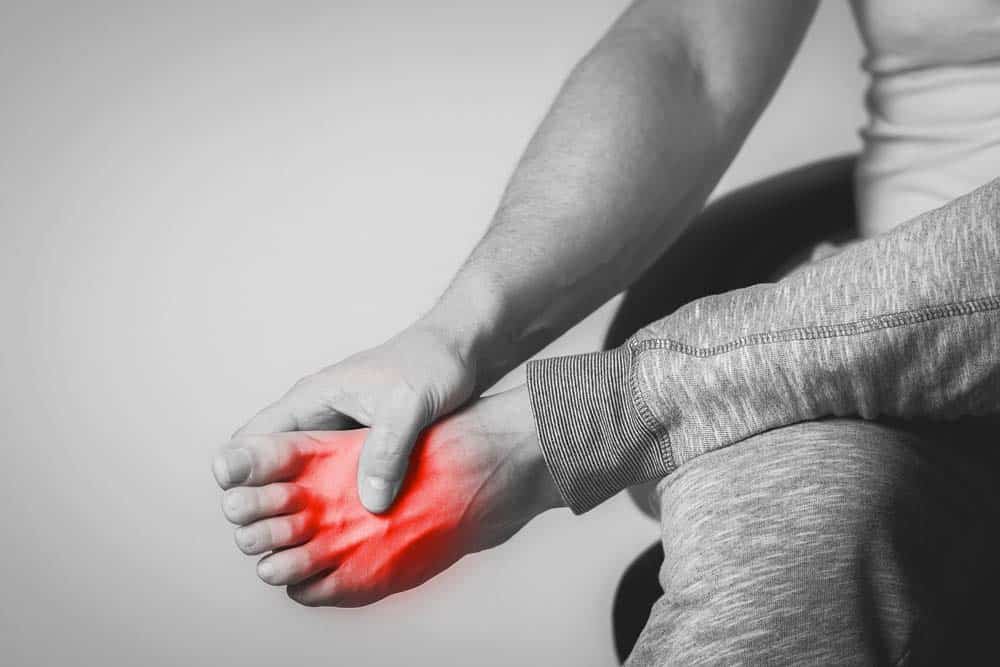Are you experiencing pain on top of your foot? We know exactly how annoying and frustrating that can be.
It’s extremely difficult to go about your day to day life when anything hurts… let alone one of your most used body parts. As such, we created this guide to cover a plethora of potential causes for upper foot pain.
Up next, we’ll discuss some of the reasons why people experience foot pain, and we’ll talk about some of the many treatment options your doctor might recommend.
NOTE: This article is not intended as medical advice and is available for informational purposes only. If you’re experiencing pain on the top of your foot, it’s best to speak with a medical professional as soon as possible.
Contents
Why Does The Top Of My Foot Hurt?
Pain on the top of the foot is fairly common, yet it can be caused by a whole host of different issues. Here are some of the most likely reasons why you might experience top of foot pain:
Acute Injury
If you were recently playing sports, exercising, or tripped (before your foot pain started), there’s an excellent chance that you injured your foot from one of these common activities.
Your injury could be as simple as a bruise or as complex as a sprained metatarsal (midfoot sprain). Alternatively, you might have a stress fracture, which is popular among runners or anyone else that performs a lot of repetitive movements.
With an acute injury to the top of the foot, you normally experience signs and symptoms, such as swelling and bruising. This pain starts immediately, soon after an injury, or during exercise, which typically helps distinguish it from other types of pain in the top of the foot.
Tendonitis & Osteoarthritis
Although these are 2 entirely separate types of conditions, they often present with similar signs and symptoms, especially in the foot.
Tendonitis, in particular, is an inflammation of the tendon. Tendons are the thick bands of tissue that connect our muscles to our bones. Without them, we wouldn’t be able to move!
On the other hand, osteoarthritis is one of the most common types of arthritis, which is a condition that causes swelling and tenderness in the joints. Unfortunately, the bones in the middle of the foot are among the most likely places that people develop arthritis, especially later in life.
In both of these conditions, people often experience a variety of signs and symptoms, including:
- Lumps along a tendon
- Cracking whenever you move the foot
- Long-lasting stiffness
- Swelling
- Pain
Unfortunately, determining whether tendonitis or osteoarthritis is the cause of your foot pain requires a medical exam by an experienced physician.
Gout
Gout is actually a type of arthritis, so it causes inflammation and pain in the joints. Usually, gout affects just one joint at a time (such as the big toe), but it can also affect the top of the foot.
Interestingly, gout is actually caused by a build-up of uric acid within the body. The human body naturally produces uric acid when it has to break down compounds known as purines.
That being said, some foods and beverages contain higher concentrations of purines than others. These food and drinks include:
- Alcohol
- Red meat
- Organ meat (e.g., liver)
- Anchovies
- Muscles
- Scallops
- Tuna
- Trout
- Sardines
- Herring
- Codfish
Other factors, such as being male or obese, or having conditions like congestive heart failure, diabetes, poor kidney function, high blood pressure, and insulin resistance, can all increase your likelihood of developing gout.
With gout, people normally experience other signs and symptoms in addition to intense pain. This can include substantial swelling, lots of redness, and a sensation of heat throughout the joint.
Unfortunately, gout can be difficult to diagnose because it’s usually only noticeable through medical tests during a flare-up. Therefore, if you’re experiencing pain on the top of your foot (in addition to a heat sensation and swelling), see your doctor as soon as possible.
Sinus Tarsi Syndrome
Sinus tarsi syndrome is a condition that can happen after an injury (particularly an ankle sprain) when someone has a very pronated foot (one that rolls inward). The condition normally causes localized pain, instability, and a sensation of looseness in the foot, especially when bearing weight on uneven surfaces.
Sometimes doctors can identify sinus tarsi syndrome through bone scans, X-rays, CT scans, and MRIs. However, more often than not, the condition is identified through a process of elimination. When all other conditions have been ruled out, sinus tarsi syndrome is sometimes to blame for top of the foot pain.
Bone Spurs
Despite what the name might imply, a bone spur is actually a smooth growth that forms on a bone. While the bone spur itself is not inherently painful, it can cause pain when it pinches against a nerve or another piece of soft tissue.
Although the signs and symptoms of bone spurs depend greatly on where the spur is in the body, many people experience burning and tingling sensations, stiffness, redness, and swelling.
Bone spurs on the top of the foot are commonly caused by osteoarthritis. Typically, a doctor will use imaging (such as an X-ray or MRI) to identify bone spurs on the top of the foot.
How To Treat Pain On The Top Of The Foot
With the exception of acute injuries, pain on the top of the foot is actually a symptom rather than a stand-alone problem. Therefore, in most cases, the best course of treatment is to deal with the underlying issue.
For example, with gout and osteoarthritis, you’ll often need to see a rheumatologist, which is a doctor that specializes in the various forms of arthritis. Rheumatologists will help you manage your gout and arthritis-related pain. They can also help you determine what lifestyle changes, medications, or treatments are best for treating your condition.
Bone spurs, on the other hand, can be treated by orthopedists, rheumatologists, internists, and general physicians. Treatment for bone spurs depends greatly on the severity of the issue. Some options include orthotics, anti-inflammatories, and cortisone injections. In certain cases, when all else fails, surgery is also an option.
Tendonitis and sinus tarsi syndrome often require the care of an orthopedist. Your orthopedist may also refer you to a physical therapist for rehabilitation and muscle strengthening. In addition to physical therapy, you may be prescribed anti-inflammatories, steroids, or orthotics.
Finally, acute injuries are treated based on the severity of the injury. For minor sprains, most people find that the pain goes away after a few weeks with the standard RICE treatment protocol used for ankle sprains. More serious injuries, such as stress fractures, warrant a visit to the doctor.
Final Thoughts
Pain on the top of the foot can be caused by an injury or a plethora of different medical issues. These conditions can be difficult to differentiate, so it’s important to go to the doctor if you’re experiencing persistent top of the foot pain.
With a doctor’s help, you can identify your foot pain’s underlying cause and find a treatment plan that works for your needs. When in doubt, it’s worth discussing your top of foot pain with your primary physician, who can then refer you to a specialist if you need further care.








Leave A Comment